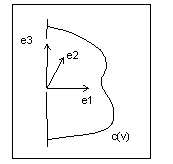Example: General Surface of Revolution Data Format
To create a general surface of revolution, you rotate a curve entity, usually a spline, around an axis. The system evaluates the curve at the normalized parameter v, and rotates the resulting point around the axis through an angle u. The surface of revolution data structure consists of a local coordinate system and a curve structure The curve must be planar; that is, the x coordinate must be greater than or equal to zero and the y coordinate must be zero. The following illustration shows a surface of revolution.

Data format:
e1[3] | (dbl) | |
e2[3] | (dbl) | |
e3[3] | (dbl) | |
origin[3] | (dbl) | Origin of the local coordinate system |
C | (curve structure) | Generating curve |
Parameterization:
C (v) = (c1, c2, c3) is a point on the curve.
(x, y, z) = [c1 * cos(u) - c2 * sin(u)] * e1 + [c1 * sin(u) + c2 * cos(u)] * e2 + c3 * e3 + origin